Introduction
The African painted dog, also known as African wild dog and African hunting dog, is a carnivorous member of the canine family. African painted dogs have sandy fur with mottled markings, as if dabbed on with a paint brush. They are one of the largest wild dogs, standing over two feet tall (60 to 75 cm) at the shoulders, and measuring up to five feet (100 to 153 cm) from head to tail. Adults weigh between three and six stone (18 to 36 kg). African wild dogs live for 10-11 years in the wild.1https://animaldiversity.org/accounts/Lycaon_pictus/
African painted dogs are one of the most endangered dogs in the world. Only 6,679 remain in the wild2https://www.iucnredlist.org/species/12436/166502262#population, and they are extinct in most countries in West and Central Africa. In east and South Africa they are confined to a few small areas with low human populations.3https://portals.iucn.org/library/sites/library/files/documents/1997-052.pdf African painted dogs were wiped out in Uganda in the 1980s but there have been recent reports of a pair spotted again in the country.4https://phys.org/news/2023-06-african-dogs-uganda-decades.html
Fascinating facts
A god amongst dogs
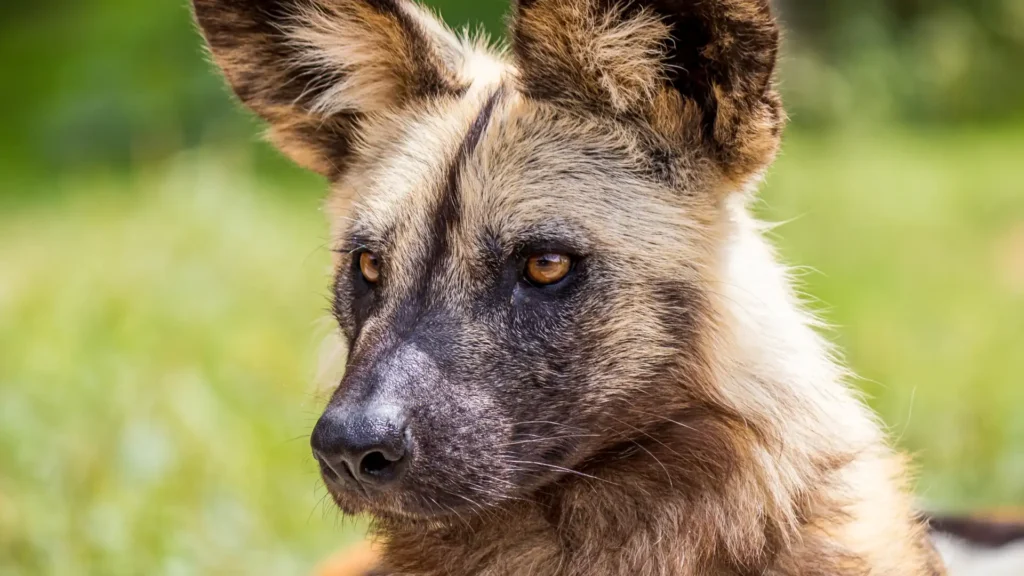
African painted dogs were celebrated by the ancient Egyptians for bringing order over chaos. They have also been depicted as guardians over the land, keeping nature in balance – a role they actually play as a keystone species, by hunting herbivorous animals and keeping their populations healthy.5https://www.oneearth.org/species-of-the-week-african-wild-dog/
Role models
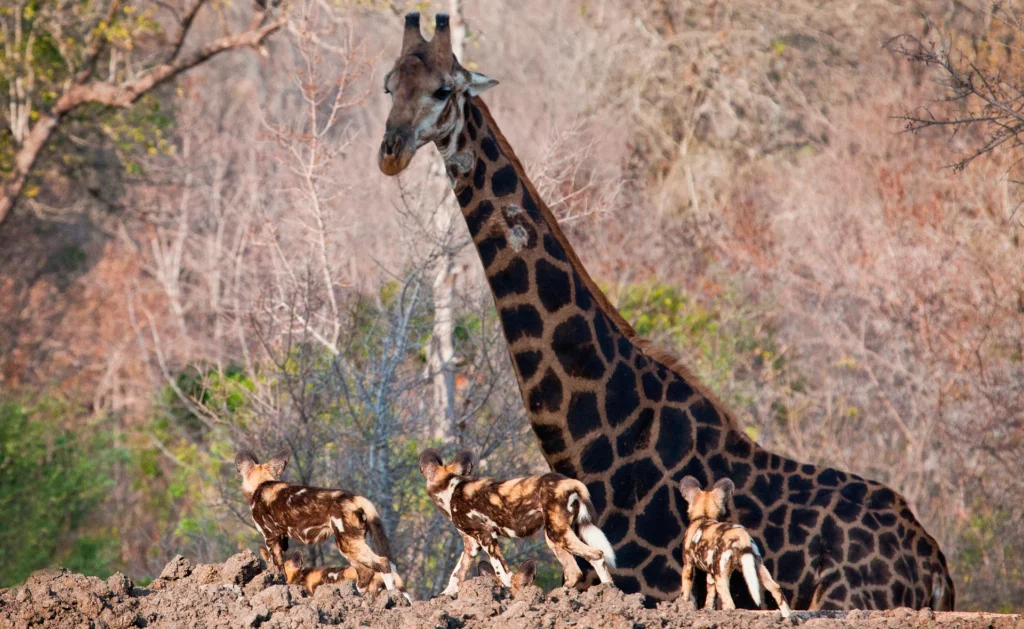
The hunting skills of African painted dogs are so well-respected by the Indigenous San people of Botswana that they sometimes apply the bodily fluids of wild dogs to their feet in the hopes that they will be granted the dogs’ super stamina, agility and courage.5https://www.oneearth.org/species-of-the-week-african-wild-dog/
Colourful coats

The short fur of an African painted dog is a vibrant mix of brown, red, black, yellow, orange and white. Every pattern is unique, like the stripes of a zebra. Their scientific name, Lycaon pictus, literally means painted wolf.1https://animaldiversity.org/accounts/Lycaon_pictus/
Big ears
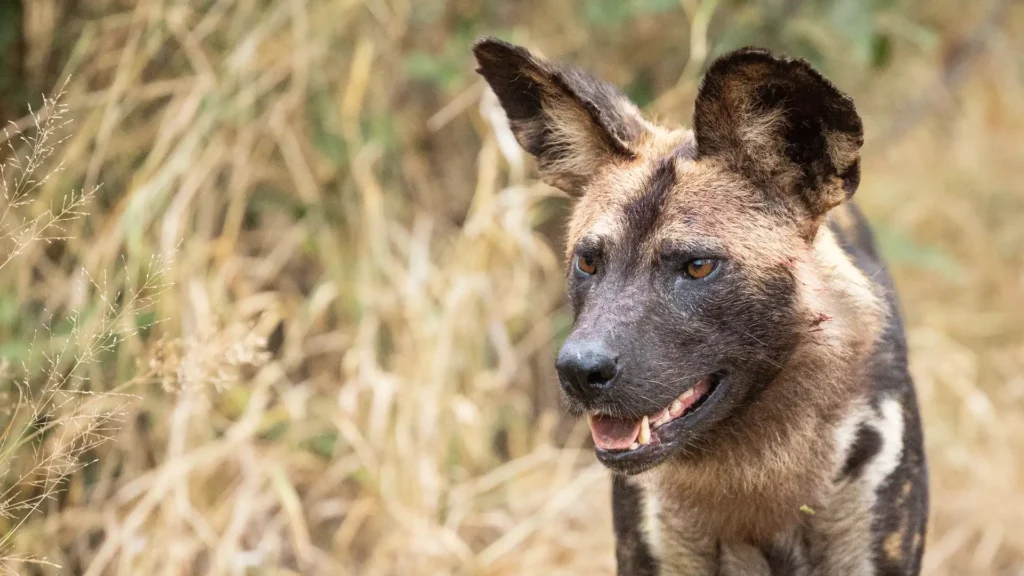
When you first see an African painted dog, you might be struck by the huge size of their circular ears. But their big ears do a very important job. Just like elephants, the big ears of a painted dog allow them to regulate their body temperature so they can stay cool in the heat. This also increases their stamina which is why they are such good hunters.
Happy together
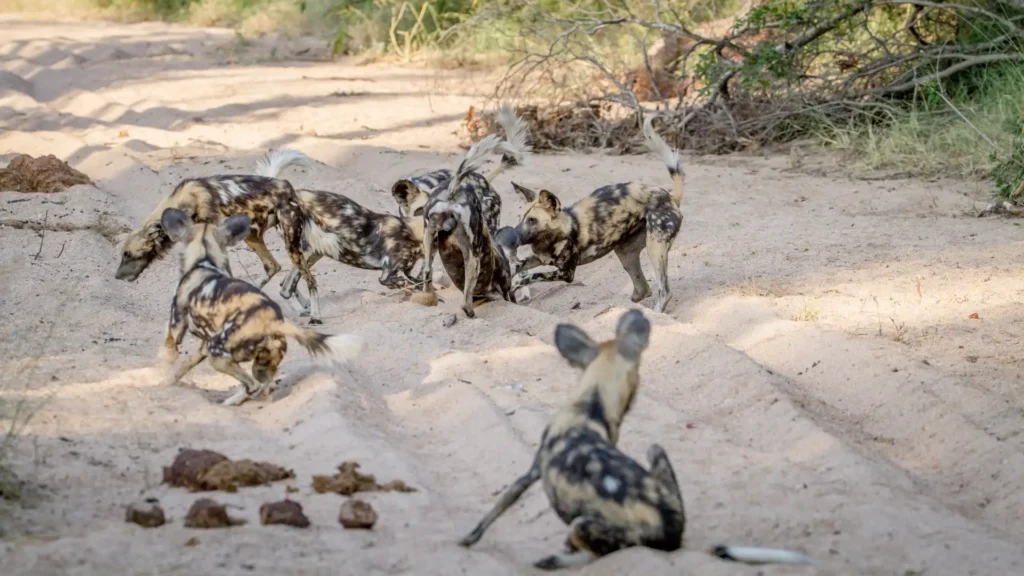
African painted dogs like to live in packs of up to 40 members. In the past, when there were more dogs in the wild, they’d even form packs of 100, but now most packs are only made up of between seven and 15 members.
His and hers

The pack is led by a dominant mating pair. Males and females have separate hierarchies in the pack, so males only compete with other males and females with other females. Packs are about 60 per cent male and 40 per cent female.2https://www.iucnredlist.org/species/12436/166502262#population Female dogs are more likely to leave the pack and join another with fewer adult females, and about half of young males stay with their father’s pack while the other half leave to form their own.1https://animaldiversity.org/accounts/Lycaon_pictus/
Shared parenthood

African painted dogs become ready to breed when they are between 12 and 18 months old but they do not usually mate until they are at least two years old. Usually, only the dominant pair is allowed to breed but sometimes another female will be allowed to mate and raise young. After 10 weeks, the mother gives birth to between two and 20 pups. After about a month, the pups are brought out of their den and it is then up to the whole pack to look after them.1https://animaldiversity.org/accounts/Lycaon_pictus/
Community comes first
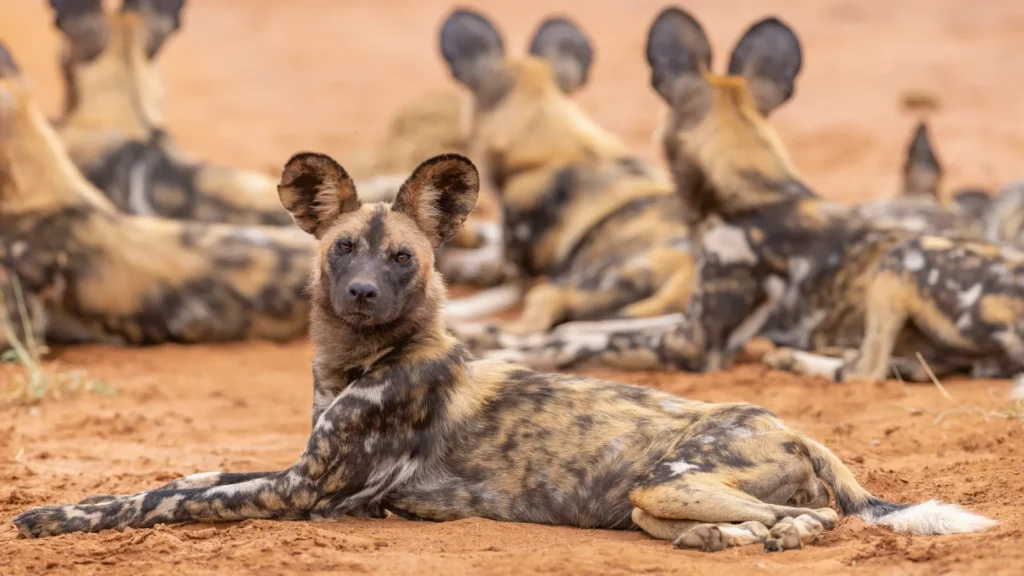
African painted dogs have very high social intelligence. They share caring for the young as well as for sick or wounded members of the pack. They will regurgitate food for the puppies and any other dog that wasn’t able to go on the hunt. The pack is generally very peaceful with very few fights breaking out, except for when females compete for breeding rights.1https://animaldiversity.org/accounts/Lycaon_pictus/
Hunting party
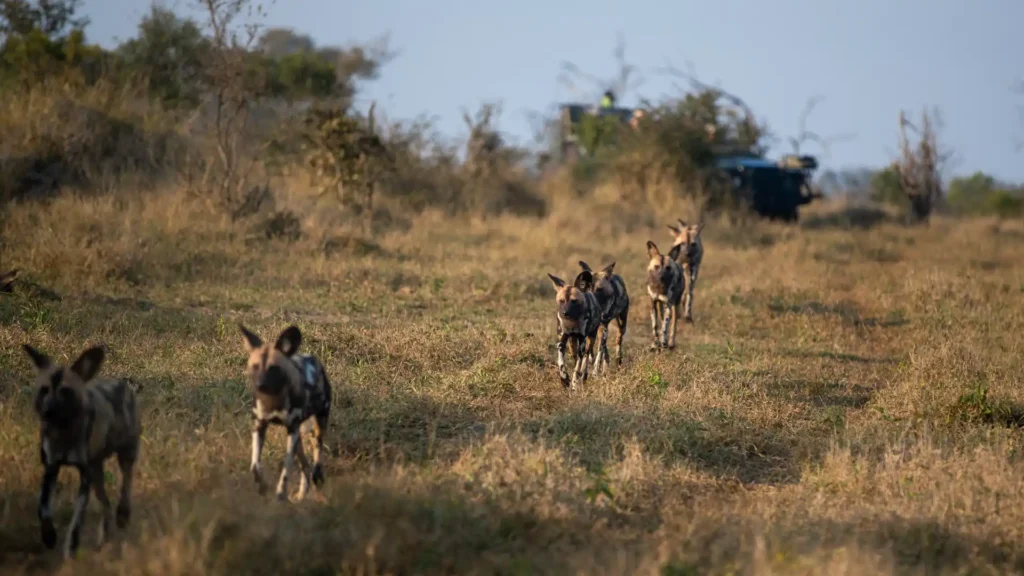
African painted dogs hunt in packs led by the dominant male. They prey on animals twice their size such as gazelles and wildebeest young, as well as small animals such as rats and birds. They chase their prey until they become worn out and either collapse or are caught by the dogs. African wild dogs are fussy eaters – they do not like to scavenge, preferring to eat what they can hunt.
Evolved for efficiency
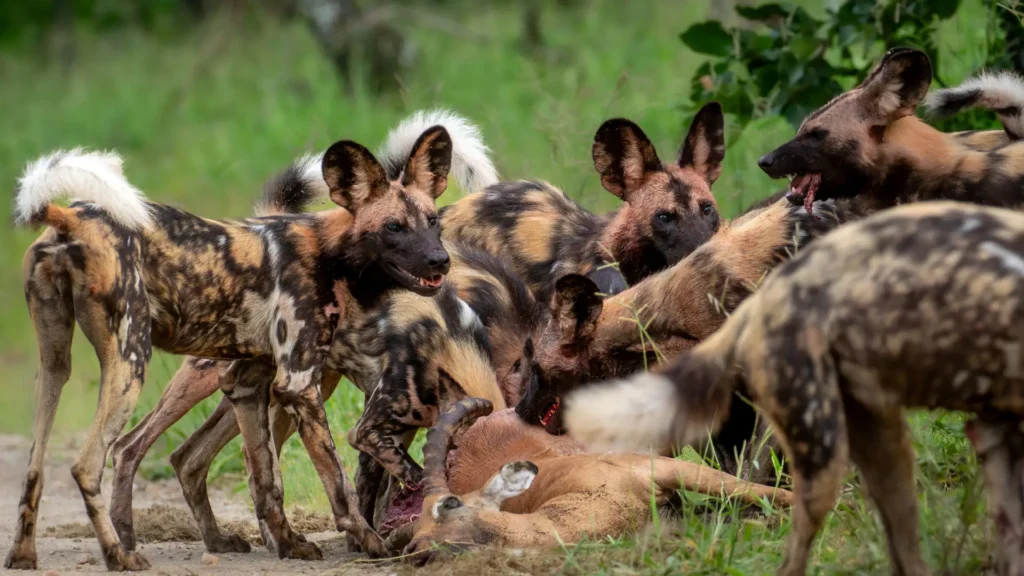
African painted dogs only have four toes on their forefeet — unlike other dog species they have no dewclaw. This adaptation gives them a better speed and stride length so they can pursue prey across long distances. Their teeth are also especially suited to slicing through the flesh of their prey.
Nomadic dogs
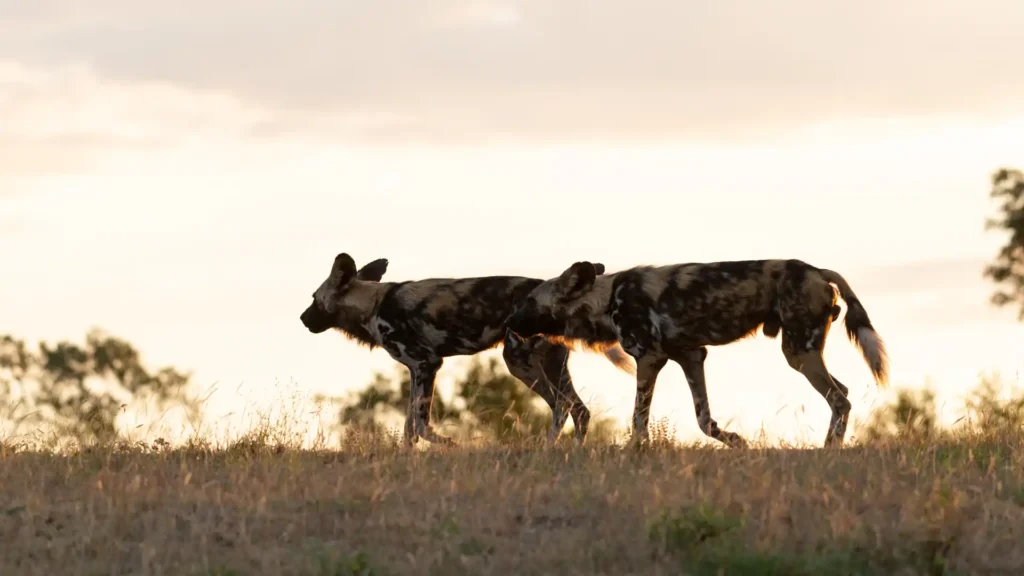
African painted dogs are not territorial. Instead, they are always on the move and roam vast areas of between 125 and 1,250 square miles (200 and 2,000 km2).1https://animaldiversity.org/accounts/Lycaon_pictus/ Because they need such a large area to thrive, habitat loss has had a huge impact on their well-being.
Threats to African painted dogs
The ultimate cause of the wild dogs’ decline is habitat loss and fragmentation, which has led to conflict between humans and the dogs, and the spread of infectious diseases.2https://www.iucnredlist.org/species/12436/166502262#population
Habitat loss

Habitat loss due to animal farming is a major threat to African painted dogs. As a result of Uganda’s population growth, expanding towns and cities, and an increased income for wealthier Ugandans, the demand for animal products is likely to dramatically rise in the coming years. The FAO estimates that by 2050, the demand for meat and milk products in Uganda will more than double and “the production of all types of meat and that of milk will increase by 164 and 41 per cent, respectively.”6https://www.fao.org/3/ca7009en/CA7009EN.pdf
To produce these animal products, land that was once beautiful and iconic savannah and forest – and home to the African painted dog – is being turned into farmland. To survive, African painted dogs need a lot of savannah to roam and hunt, but it’s being turned into farms and divided by roads. The conversion of land to farmland is stripping the dogs of their natural habitat and making it impossible for them to survive.
Of course, a growing population needs food but it would be much more sustainable to meet these needs through the growing of crops instead of farming animals. Animal farming requires the most land and resources because land is used for grazing as well as growing food for the animals. It is also a very inefficient system. To get just one kilogram of beef from a cow, you have to feed them 25 kilograms of crops – only a tiny amount of protein and calories in the crops gets converted to beef. In other words, you have to put a lot of food into an animal but get very little back. It would be better if humans just ate the crops instead of the cow!
The more animal-based foods we eat, the more natural habitats we lose. However, crops are a far more efficient way to feed the growing population and use less land and other natural resources. A vegan diet is associated with only half the cropland demand, grazing intensity and overall biomass harvest of meat-based diets7https://www.nature.com/articles/ncomms11382 so switching to a vegan diet would have a phenomenal impact on reducing habitat loss in Uganda.
Human-wildlife conflict
As the painted dog’s habitat shrinks and becomes taken over by humans and farmed animals, conflict follows. African painted dogs are losing their habitat and the animals they once hunted are being replaced by farmed animals. With less natural prey to hunt, the dogs have to sometimes prey on farmed animals to survive. This is always a last resort as African painted dogs prefer to hunt wild animals and like to stay away from human settlements. Out of an act of revenge, farmers shoot any wild dogs they see – even if they have no proof the dog actually killed the farmed animal.
Poaching
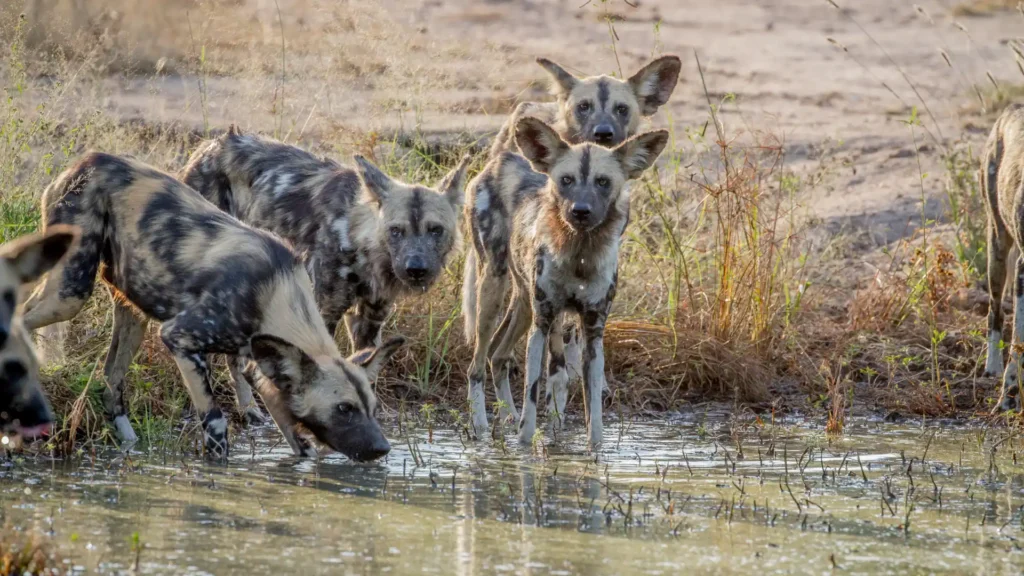
Poaching is an ongoing threat to African painted dogs. They are killed for their fur and for their flesh. Their fur is used to make traditional clothing and their flesh is used for bushmeat. They are often caught in horrific wire snares. Snares causes horrendous suffering as the dogs either bleed to death due their wounds or starve to death if the snares are not checked regularly. Some dogs even chew their own feet off in an attempt to escape the snare’s gruesome grip. This will almost always result in an infection and death for the dog.
Disease
Rabies has had a devastating impact on the African painted dog population. In 2015, one outbreak of the horrendous disease killed 29 members of a 35-dog pack. It is suspected that African painted dogs catch rabies from domestic dogs, often accompanying poachers.8https://www.ncbi.nlm.nih.gov/pmc/articles/PMC7105255/ As human towns grow and spill into the natural habitats, the wild dogs have more interactions with stray and feral dogs which increases their risk of catching diseases. Because African painted dogs have such complex social structures, when many die from rabies their whole social life is thrown into disarray. This is just one more example of how human exploitation of the natural world is bad news for wildlife.
References
References
- 1
- 2
- 3
- 4
- 5
- 6
- 7
- 8

